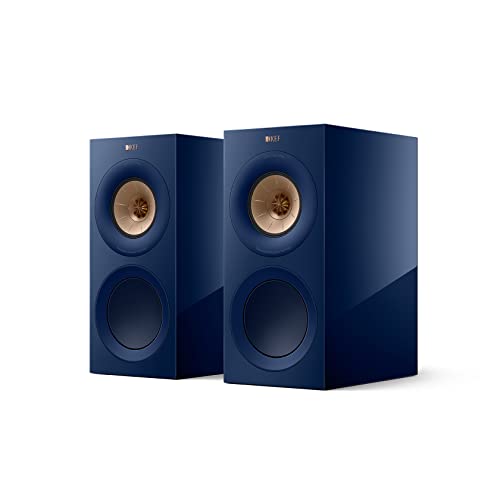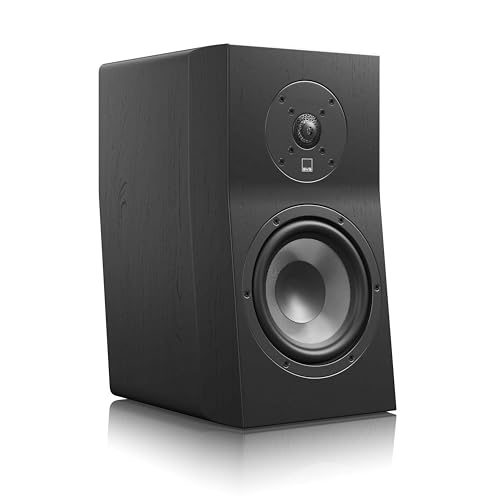Best Speakers for Pure Sound Quality
As an Amazon Associate I earn from qualifying purchases. Some links may earn us a commission at no extra cost to you.
If you’re chasing pure fidelity, focus on speakers with neutral tuning, controlled directivity, solid cabinets, and proven measurements—not app features. Most top performers here are passive (you’ll need an amp), plus one powered option for a clean, minimalist setup.
How I researched
Deep dives, and lab tests (spinoramas, anechoic/nearfield data), prioritized neutral frequency balance, off-axis behavior, and low distortion, checked amp/load compatibility and room fit, and noted current availability/EOL changes. I weighed tonality, imaging/soundstage, bass extension vs. size, build quality, and long-term ownership.
Top picks
KEF R3 Meta — Best overall bookshelf for neutrality
Compact 3-way bookshelf that measures superbly and images like a laser—ideal when you want “hear the mix” accuracy.
Why it wins: True 3-way Uni-Q + MAT delivers class-leading linearity and smooth directivity for natural in-room response.
- R3 Meta redefines bookshelf speaker’s performance. Sharing the same drivers as the range-topping R11 Meta, the R3 Meta is a true three-R3 Meta redefines bookshelf speaker’s performance. Sharing the same drivers as the range-topping R11 Meta, the R3 Meta is a true three-way design.way design.
- R3 Meta featues KEF's 12th generation Uni-Q driver array with MAT and a powerful 6.5” hybrid aluminium bass driver that pushes performance to new extremes.
- Meta Material Absortion technology absorbs 99% of unwanted sound for the most pure and natural sound.
Pros
-
True 3-way; superb mid clarity
-
Consistent off-axis; easy toe-in
-
Excellent build for size
-
Scales with good amplification
Cons
-
Needs quality power; 4-ohm load
-
Larger than typical bookshelves
-
Stand placement strongly recommended
Social proof
Broadly praised by measurement-driven reviewers for linear response and imaging (see reviews on Amazon).
Trade-offs / Who should skip
If you want big-room bass without a sub, a larger cabinet or floorstander is better.
Scores: Performance 5/5 · Frequency balance 5/5 · Ease of Use 3.5/5 · Value 4/5
KEF LS50 Wireless II — Best powered “all-in-one” for purity
Audiophile-grade powered pair with DSP room tools and hi-res streaming—no separate amp needed.
Why it wins: Integrated amps/DSP around KEF’s Uni-Q + MAT yield remarkably clean, coherent sound with wide connectivity.
- Available streaming services include: Spotify Connect, Tidal, Amazon Music, Qobuz, Deezer, QQ Music, Internet Radio, and Podcasts.
- Each speaker consists of a 280 watt amplifier for the mid range and 100w amplifier for the tweeter.
- Wireless Streaming features include: Apple AirPlay 2, Google Chromecast, ROON Ready, UPnP Compatible, Bluetooth 4.2
Pros
-
End-to-end system; tidy setup
-
Excellent imaging; low distortion
-
App-based DSP/EQ flexibility
-
HDMI ARC for TV integration
Cons
-
Not ideal for ultra-loud rooms
-
App ecosystem learning curve
-
Turntable users may need external phono
Social proof
Consistent expert praise for sound quality and ease (see reviews on Amazon).
Trade-offs / Who should skip
If you prefer swapping amps/DACs, go passive.
Scores: Performance 4.5/5 · Frequency balance 4.5/5 · Ease of Use 4.5/5 · Value 4/5
Polk Reserve R200 — Best value for audiophile detail
A neutral-leaning, big-sounding bookshelf that punches above its price when powered well.
Why it wins: Measured response is commendably linear with strong bass for size; the Pinnacle tweeter and Turbine Cone woofer are the real deal.
- TECHNOLOGICALLY SUPERIOR, LARGE BOOKSHELF SPEAKER - The Polk Reserve R200 Loudspeaker features a 1" Pinnacle Ring Radiator Tweeter & a 6.5" Turbine Cone Woofer that deliver ultra-clear, crisp highs, smooth, detailed midrange & effortless bass
- EXCEPTIONAL AUDIO PERFORMANCE - With Hi-Res Audio Certification, Dolby Atmos and IMAX Enhanced, this speaker delivers clear and dynamic high-frequency response with unmatchable audio clarity. Supports hi-res audio formats like DSD, FLAC, WAV, ALAC and MQA
- DEEP, IMPACTFUL BASS - Features a bass reflex cabinet with a rear-firing port and Polk's Patented X-Port Technology with Eigentone Filter (ETF) that eliminates unwanted noise, offering tight, distortion-free bass for your music, movies, and video games
Pros
-
Neutral tuning; good bass reach
-
Works in small to medium rooms
-
Quality cabinet/damping
-
Friendly placement vs. ports
Cons
-
4–6Ω behavior; wants a stout amp
-
Slight presence-region energy for some
-
Grilles subtly soften top-end
Social proof
Widely recommended by objective-test reviewers; solid owner sentiment (see reviews on Amazon).
Trade-offs / Who should skip
For super-warm voicing, Wharfedale’s Linton fits better.
Scores: Performance 4/5 · Frequency balance 4/5 · Ease of Use 4/5 · Value 4.5/5
SVS Ultra Evolution Bookshelf — Best for dynamics and “live” energy
Modern, high-output bookshelf with crisp transient snap and wide soundstage.
Why it wins: Updated drivers/cabinet and proven linearity make it lively yet controlled; great macro-dynamics for rock and film scores.
- Reference flagship bookshelf speaker that delivers reference sound for both two-channel audiophiles and home theater fans
- Composite glass-fiber cone with excellent stiffness/mass ratio for high sensitivity and pistonic behavior
- Chamfered front baffle and flush-mounted drivers improve on-axis and off-axis high-frequency response
Pros
-
Punchy dynamics; stays composed loud
-
Clear imaging; engaging top end
-
Dual posts allow bi-amp/bi-wire
-
Solid build; premium finishes
Cons
-
Forward energy isn’t for everyone
-
Benefits from careful toe-in
-
Likes power; modest sensitivity
Social proof
Positive expert takes on clarity/dynamics; enthusiastic owner feedback (see reviews on Amazon).
Trade-offs / Who should skip
If you prefer a relaxed, vintage vibe, see Linton.
Scores: Performance 4/5 · Frequency balance 3.5/5 · Ease of Use 3.5/5 · Value 4/5
Wharfedale Linton — Best for relaxed, big-room musicality
Large, retro 3-way that sounds spacious, weighty, and non-fatiguing—great with jazz, classic rock, and vocals.
Why it wins: 8″/5″/1″ three-way design with higher sensitivity delivers deep, effortless bass and a natural midrange; beloved for its easygoing tonality.
- Wharfedale Linton 85th Anniversary Speakers only - stands sold separately
- Sensitivity (2.0V @ 1m): 90dB
- Recommended Amplifier Power: 25-200W
Pros
-
Full-bodied bass; room-filling scale
-
Smooth, warm balance; long sessions
-
Easy to drive; amp-friendly
-
Matching stands available
Cons
-
Large; needs space from walls
-
Not for clinical neutrality chasers
-
Grille-on changes treble slightly
Social proof
Long-term favorite among music-first listeners; strong pro reviews (see reviews on Amazon).
Trade-offs / Who should skip
Tight spaces or “mix-engineer” neutrality needs—choose KEF R3 Meta instead.
Scores: Performance 4/5 · Frequency balance 3.5/5 · Ease of Use 4/5 · Value 4.5/5
Quick compare (table-free)
-
KEF R3 Meta — Best for neutrality: 3-way accuracy, imaging champ; needs quality amp.
-
KEF LS50 Wireless II — Best powered system: DSP-aided purity and streaming; SPL limits vs. big rooms.
-
Polk Reserve R200 — Best value: Linear response, strong bass for size; benefits from robust amplification.
-
SVS Ultra Evolution Bookshelf — Best dynamics: Lively, spacious; slightly forward treble if you’re treble-sensitive.
-
Wharfedale Linton — Best relaxed listen: Big, warm stage; too large for tight setups.
Buying guide
Pick by room & placement
-
Small rooms/nearfield: Compact monitors with controlled directivity image best (KEF pairs).
-
Medium to large rooms: Larger cabinets/woofers give scale and ease (Linton, SVS).
Power & compatibility
-
Passive picks here can dip toward 4–6Ω; choose an amp that’s stable and has real current delivery. The R3 Meta is nominally 4Ω; the R200 behaves close to 4Ω in parts of the band.
Tuning preferences
-
Studio-neutral: KEF R3 Meta
-
Engaging/energetic: SVS Ultra Evolution
-
Warm/easy: Wharfedale Linton
-
One-box simplicity with fidelity: LS50 Wireless II (adds DSP/EQ to tame rooms)
Subwoofer or not?
For full-range at higher levels, add a musical sub and cross around 60–80 Hz; otherwise the R3/Linton already reach pleasantly deep for music. LS50 Wireless II offers sub out with bass management in the app.
Certifications/recalls: Couldn’t verify UL/ETL or any relevant recalls for these passive models; KEF publishes detailed spec sheets for LS50 Wireless II electronics.
FAQs
Q: Do I need an amplifier for these?
A: Yes for the passive models (KEF R3 Meta, Polk R200, SVS Ultra Evolution, Wharfedale Linton). The KEF LS50 Wireless II is powered—no external amp required.
Q: How far from the wall should I place them?
A: Start ~8–24 inches from the back wall; ported designs benefit from some breathing room. Use toe-in until the center image locks (KEF’s coaxials are forgiving).
Q: Which is the most “mix-engineer neutral”?
A: KEF R3 Meta measured the most linear here; Polk R200 is close with slight presence-region character.
Q: What if I don’t want a sub?
A: For fuller low end without a sub in medium rooms, Wharfedale Linton or SVS Ultra Evolution provide more weight thanks to larger cabinets/drivers.
As an Amazon Associate, I earn from qualifying purchases.





